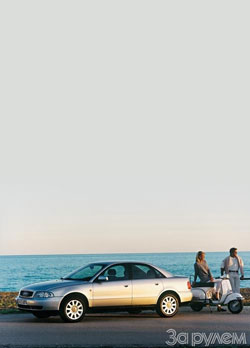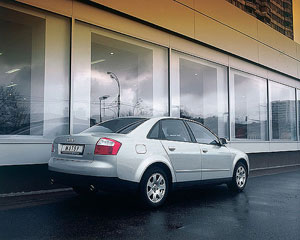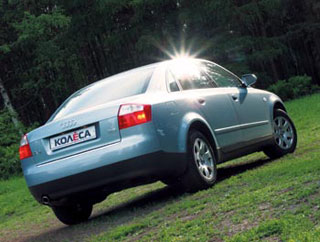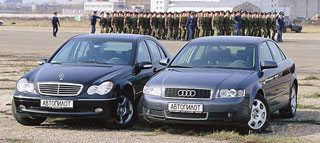Test drive Audi A4 B6 2001 - 2004 sedan
Four sign
 Evolution Audi A4
Evolution Audi A4 1994. In October, the release of the A4 sedan, which replaced the Audi 80. Benzine engines: eight -valve 1.6 l (101 l.), Twenty -valve 1.8 liters (125 hp), 1.8t with turbocharged ( 150 hp.), Twelve -valve V6 2.6 liters (150 hp), thirty -valve V6 2.8 liters (193 hp). A turbodiesel with direct fuel injection 1.9 liters (110 l.). Gearboxes: five -speed with manual switch and four -speed automatic. Drive: front or permanent full with differential torsen.
1995. In November, the release of Avant wagon.
1999. Restyling. A full -wheel drive 1.8t Quattro with an 180 -liter engine. With.
2000. The second generation A4.
Evolution Audi A6
1994. Rename Audi 100, produced since 1990. Gasoline engines: 2.0 liters (101 (monovxics)/115 l. P.), V6 2.6 l (150 hp), V6 2.8 l (174 hp). Diesel with direct fuel injection: 1.9 l (90 hp), a one five -cylinder 2.5 l (115/140 h.). Boxes, transmission - the same as the A4. Body: Sedan and Universal (Avant).
1997. The new generation A6 is represented. The platform is similar to A4. Engines with five valves per cylinder: 1.8 liters (125 hp), 1.8t (150 hp), V6 2.4 l (165 hp), V6 2.8 l193 l. p.), V6 2.7 liters (230 l. p.). Turbodieseli with direct fuel injection: 1.9 l (110 hp) and 2.5 l V6 24V (150 l.).
1998. New station wagon.
1999. A full -wheel drive luxury model A6 4.2 with the V8, 300 hp motor
2000. The next generation A6.
 The competition in the trinity of the Mercedes - BMW - Audi was only beneficial: even a relatively modest Audi A4 in dimensions does not make the impression of a cheap car - the situation obliges. Today, four and sixes are many in the Russian market. Once, large organizations ordered them in whole batches. Now the five-six-year-old A4 in Moscow costs about 14 thousand dollars. A6 - more expensive: 15-16. These machines will suit lovers of lighting up, and those who want to relax at the wheel: a frisky motor, excellent handling, elegant finish - what else does the buyer need? Yes, they almost forgot - reliability. How much are these cars in operation? We have already written about problems with four from the first parties (ZR, 2000, No. 12). What has changed over the years, we were helped by the specialists of the Moscow authorized technical center Yusha-Service.
The competition in the trinity of the Mercedes - BMW - Audi was only beneficial: even a relatively modest Audi A4 in dimensions does not make the impression of a cheap car - the situation obliges. Today, four and sixes are many in the Russian market. Once, large organizations ordered them in whole batches. Now the five-six-year-old A4 in Moscow costs about 14 thousand dollars. A6 - more expensive: 15-16. These machines will suit lovers of lighting up, and those who want to relax at the wheel: a frisky motor, excellent handling, elegant finish - what else does the buyer need? Yes, they almost forgot - reliability. How much are these cars in operation? We have already written about problems with four from the first parties (ZR, 2000, No. 12). What has changed over the years, we were helped by the specialists of the Moscow authorized technical center Yusha-Service. Audi A6 of the 1994 model actually retained the filling of the previous hundredth model, while A4 became a completely new machine. Their platforms came closer in 1997, with A6 updates. We will talk about all three. (
Oil canister - in the engine, the other - in the trunk
 Gasoline engines, especially the V6 and V8, love oil. However, a liter per 1000 km of run is not a reason for concern: this is a permissible limit declared by the manufacturer. With an active ride style, consumption is rarely lower than 0.4-0.5 liters per thousand, therefore, going on vacation to the sea, take the canister with oil in reserve. It is worth controlling its level at each gas station. The consumption is highly dependent on the revolutions: if you do not allow the tachometer arrow to run in the mark of 3000, it is reduced significantly. But what kind of pleasure all the time to keep in Uzda a frisky motor? Excessive oil appetite will mention the replacement of oil-cutting caps of valves: by 150-170 thousand km, they lose elasticity.
Gasoline engines, especially the V6 and V8, love oil. However, a liter per 1000 km of run is not a reason for concern: this is a permissible limit declared by the manufacturer. With an active ride style, consumption is rarely lower than 0.4-0.5 liters per thousand, therefore, going on vacation to the sea, take the canister with oil in reserve. It is worth controlling its level at each gas station. The consumption is highly dependent on the revolutions: if you do not allow the tachometer arrow to run in the mark of 3000, it is reduced significantly. But what kind of pleasure all the time to keep in Uzda a frisky motor? Excessive oil appetite will mention the replacement of oil-cutting caps of valves: by 150-170 thousand km, they lose elasticity. Multicked engines are very demanding on oil level. If on old motors even riding with a dry probe, often left the hands, then the fall of the level below the minimum is unacceptable. The hard sound of the engine is the first alarm signal (the emergency oil pressure lamp may not light up). First of all, the timing shafts wear out, and the jammed shaft on a multi -valve (five valves on the cylinder) engine leads to a break of the belt and meeting valves with pistons.
 If the level is normal, and the engine works noisily, the cause of oil starvation may be a defective valve defect in the highway. This is characteristic of 1.8-liter engines, where the valve fixed in the oil filter bracket is unscrewed from vibrations. When replacing it, it makes sense to fix it with anaerobic sealant: if the thread is well degreased, the problem will disappear.
If the level is normal, and the engine works noisily, the cause of oil starvation may be a defective valve defect in the highway. This is characteristic of 1.8-liter engines, where the valve fixed in the oil filter bracket is unscrewed from vibrations. When replacing it, it makes sense to fix it with anaerobic sealant: if the thread is well degreased, the problem will disappear. When the timing belt breaks, only the old eight -valve engines of 1.6 and 2.0 liters do not suffer. The rest will put the owner for a decent amount. Original belts in the mass nurse the set 120 thousand km. Early cliffs are, but the reason is usually hidden in adjacent nodes. For example, in jammed rollers or pomp. After 90 thousand km, it's time to pay attention to it: noise or backlash in the bearing - an indication for replacement. Simultaneously with the belt, its tensioner and video are changed.
On the V-shaped engines after a run of 120-150 thousand km, the gaskets of the cylinder heads often begin to flow. Before replacing them, be sure to check the plane of the haltering surfaces of the heads. When overheating of the engine or improper tightening of fasteners, they will jar. Small deviations are corrected by grinding on the stove.
 The service book provides for the replacement of candles every 60 thousand km. On our gasoline, the maximum interval is 40 thousand km. It is undesirable to rinse the nozzles on the ultrasound stand - after that they often begin to pour. It is better to use a special solvent. For replacement, you can order nozzles for poor fuel - their sprayers are less clogged with deposits. Fuel level sensors suffer from our gasoline. On Audi-Kvattro 1997 there are several in the tank. In case of refusal, it is easier to change the entire kit, as the manufacturer recommends, it is not easy to calculate the faulty sensor.
The service book provides for the replacement of candles every 60 thousand km. On our gasoline, the maximum interval is 40 thousand km. It is undesirable to rinse the nozzles on the ultrasound stand - after that they often begin to pour. It is better to use a special solvent. For replacement, you can order nozzles for poor fuel - their sprayers are less clogged with deposits. Fuel level sensors suffer from our gasoline. On Audi-Kvattro 1997 there are several in the tank. In case of refusal, it is easier to change the entire kit, as the manufacturer recommends, it is not easy to calculate the faulty sensor. If suddenly, the idle speed began to walk (it is difficult to not notice the gas stroke with the gas pedal) - get ready for the replacement of an expensive throttle knot. This usually happens after 100 thousand km. Sometimes the defect can be cured by flushing, but this is rather an exception. After replacement, it is necessary to agree on the node with the engine control unit using special equipment. This will be required when the battery is turned off.
Many cars come for repairs after home tuning. For example, the supply of fuel on a two -liter eight -valve engine ABC is regulated by a dispenser. The cogs on the case look very seductive: the receipt fell - they twisted back and forth, and the car drove. Only with black smoke from the pipe. Sometimes, after such tuning, it is not easy to restore the correct adjustments even to a professional.
 For the Russian outback, where the choice of services is not rich, simple and unpretentious eight -valve engines of 1.6 and 2.0 liters are better suited. Multicapricults are significantly more complicated and more expensive in repair and maintenance. The service life of a turbocharger largely depends on the quality of the oil and the qualifications of the driver. If you do not cool the bearings after the trip, allowing the engine to work at idle, the boost unit will fail to 100 thousand km long. As a rule, after 100-150 thousand km, the repair is inevitable, so come to the purchase of a used car with a turbocharged especially carefully. A6 with the V8 engine is a real gun, but the latter is not just expensive in repair - when worn out, the cylinder -piston group will have to change the block assembly (original pistons and rings are not supplied separately in spare parts) or install an non -original. There are few diesel A4 and A6 in Russia: specialized services are concentrated in large cities, repair and maintenance - roads. So, only a 2.5TDI belt replacement in a company service will cost $ 2,000 along with spare parts (on a gasoline engine - about half the cheaper).
For the Russian outback, where the choice of services is not rich, simple and unpretentious eight -valve engines of 1.6 and 2.0 liters are better suited. Multicapricults are significantly more complicated and more expensive in repair and maintenance. The service life of a turbocharger largely depends on the quality of the oil and the qualifications of the driver. If you do not cool the bearings after the trip, allowing the engine to work at idle, the boost unit will fail to 100 thousand km long. As a rule, after 100-150 thousand km, the repair is inevitable, so come to the purchase of a used car with a turbocharged especially carefully. A6 with the V8 engine is a real gun, but the latter is not just expensive in repair - when worn out, the cylinder -piston group will have to change the block assembly (original pistons and rings are not supplied separately in spare parts) or install an non -original. There are few diesel A4 and A6 in Russia: specialized services are concentrated in large cities, repair and maintenance - roads. So, only a 2.5TDI belt replacement in a company service will cost $ 2,000 along with spare parts (on a gasoline engine - about half the cheaper). The factory protection of the engine is plastic: from dust and light touches. Meanwhile, an aluminum pallet even with a small blow can give a crack through which hot oil will flow out for a few kilometers. On A6 after 1997 and A4 there is an enhanced composite protection - it holds a blow to medium force well. For six until 1997, you can order the original steel. There is also a similar product of Russian production on sale, but the fastening is selected unsuccessfully - to the transverse thin -walled pipe in the lower front of the motor compartment. When hitting an obstacle, such protection can pull the pipe and the front of the car, bending the radiator.
Front or complete?
 There are quite a lot of all -wheel drive audi in Russia. Cardan gear, rear gearbox, drives serve more than 200 thousand km without complaints. But still do not forget that this passenger car is not for off -road. Torn anthers of the CV joints - the verdict of the hinges, and the damaged cardan gear will have to be replaced in its entirety.
There are quite a lot of all -wheel drive audi in Russia. Cardan gear, rear gearbox, drives serve more than 200 thousand km without complaints. But still do not forget that this passenger car is not for off -road. Torn anthers of the CV joints - the verdict of the hinges, and the damaged cardan gear will have to be replaced in its entirety. Clutch on all machines is no better and no worse than classmates, it serves 120-160 thousand km with calm driving. Women often turn out to be an unexpected enemy, or rather, their hairpins are elegant, but not at all suitable for driving.
The gearboxes are not delivered. The machine requires replacing oil and filter every 50-60 thousand km. Even after a light blow to a stone or ice, be sure to check the integrity of the aluminum pallet of the manual crankcase. The machine is not so sensitive, its pallet is steel.
The bearings of the front hubs on six until 1997 and four serve on average 60 thousand km, the rear - 80 thousand km. On A6 after 1997 - 150-170 and more than 200 thousand, respectively.
Black metal
The front suspension A6 of 1997 and A4 is four -leaf. Two upper and two lower aluminum levers with ball hinges provide comfort and excellent handling. But, as you know, you need to pay for such a combination, and audi is no exception. On Russian roads, the backlash in the hinges of the lower levers usually appears already by 30 thousand km of run. The upper levers last longer - 50-60 thousand. The least durable racks of the old stability stabilizer of the old sample on A4 (with ball fingers) are often enough only 15-20 thousand km.
 The racks of a new sample (from about 1997), installed in return for the old ones-with silent blocks, they will last 3-4 times longer. Shock absorbers will require replacement every three to four years; In the absence of leaks, it is better to call on the stand - they can be still quite efficient at a neat driver. In general, the suspension wears out faster under more heavy V-shaped engines.
The racks of a new sample (from about 1997), installed in return for the old ones-with silent blocks, they will last 3-4 times longer. Shock absorbers will require replacement every three to four years; In the absence of leaks, it is better to call on the stand - they can be still quite efficient at a neat driver. In general, the suspension wears out faster under more heavy V-shaped engines. In the front suspension of the old A6 - an ordinary McExeson. Shock absorbers here serve much less - a year and a half. Symptoms - knock, backlash, leak on the rod. Also, over time, the backlash appears in the axial bearing of the upper support. But the remaining elements are much simpler and more durable. For Russia, this more rigid suspension is just right. Silent-block in the only lower steel lever will have to be changed after 40-50 thousand km, after 30-40 thousand-the rubber supports of the stabilizer rods. That's all.
The rear suspension of the front-wheel drive is very simple: a steel beam on two silent blocks. With wear, it is cheaper to change them with a couple. The approximate line is 60 thousand km. On Quattro is a complex multi -link, more than ten silent blocks. The walker is not bad (comparable to the beam), but the bulkhead is quite expensive.
 Brakes are tenacious and informative, but not without weak places. Aluminum sealing rings of the hind hoses do not resist corrosion for long: as a rule, until the third winter they do not live. So that the pedal does not suddenly fall, they should be changed along with the brake liquid - at least once every two years. In spare parts, they are supplied with a set of hoses (however, someone finds a domestic analogue). From the seductive idea to replace short -lived aluminum copper with copper, specialists dissuaded: a more solid metal may not compact the connection.
Brakes are tenacious and informative, but not without weak places. Aluminum sealing rings of the hind hoses do not resist corrosion for long: as a rule, until the third winter they do not live. So that the pedal does not suddenly fall, they should be changed along with the brake liquid - at least once every two years. In spare parts, they are supplied with a set of hoses (however, someone finds a domestic analogue). From the seductive idea to replace short -lived aluminum copper with copper, specialists dissuaded: a more solid metal may not compact the connection. The rear pads serve about twice as long as the front, and one disk (front or rear) is enough for two sets of pads. But checking the performance of the rear brake is better more often - every 20-30 thousand km. If the bracket has lost mobility, disassemble the mechanism and apply high -temperature lubricant to the guides. If the torn anthers that fall under them and water will quickly get out of order do not notice in time - then you will have to buy a caliper assembled.
By replacing the pads with A6 with the V8 engine, remember that they are asymmetric; Having mixed them up, you risk being left without brakes: with a jammed caliper and disks blue from overheating.
The steering tips are enough for 60-80 thousand km, there are no complaints about the rail. The secret of longevity of the GUR is timely and competent maintenance. It is more expensive to add something to yourself in the tank for the steering wheel. Audi allows only the proprietary G002. It is better to change it every two years, and with a strong darkening and smell of the paired - earlier. As a rule, the smell appears when the steering wheel is held for a long time in the extreme position - while the parts wear intensively. The swearing pump is no longer saved by the replacement of the liquid, sooner or later it will jam.
It seems to be a trifle ...
Moisture under the mats of the salon in the audi will not spoil the body - galvanized, primed and well -colored metal resists rust for years. But the electrician is not so impregnable - for example, the ABS block connector under the rear seat or the sensors of the side pillows, also attached to the floor. Elementary care (Korytza rugs under the feet and drying of the salon in the sun) will pay off a hundredfold.
Refused the microding microdist in the lock unit? Order a whole castle, the company does not exchange according to trifles. The same when breaking the glass of the windshield or a break of the cable is only a mechanism assembly.
It is difficult to protect yourself from cracks on headlights. In the new generation, six headlights are closed with polycarbonate (plastic) glass. It is much more durable, and scratches can be removed by polishing.
The body, as we have already said, does not succumb to Russian salt. But the enamel from the front arches, especially on the machines of the first issues, peels quickly. True, rust raids appear soon - if you paint over in time, the machine will save the presentation.
REST ONLY IN OUR DREAMS
 When buying a four-five-year-old A6, do not hope that hijackers have lost interest in it. They also order these cars. The top of the hit parade is a six with an eight -cylinder engine of 4.2 liters. Oddly enough, in this case, a rare car does not scare away, but, on the contrary, attracts hijackers. They know about the situation and insurance companies, so they have different requirements for owners A6 and A4. There are significantly fewer problems with the four.
When buying a four-five-year-old A6, do not hope that hijackers have lost interest in it. They also order these cars. The top of the hit parade is a six with an eight -cylinder engine of 4.2 liters. Oddly enough, in this case, a rare car does not scare away, but, on the contrary, attracts hijackers. They know about the situation and insurance companies, so they have different requirements for owners A6 and A4. There are significantly fewer problems with the four. When choosing a car in the market, pay attention to the factory stickers on the hood and the radiator frame. If the body parts are relatives and unpainted, the pieces of paper are glued evenly and tightly. Their absence is an almost one hundred percent guarantee that the part was changed. Some masters are cunning: re -switch the signs to new details. But once a lagging corner is given a cooled sticker. Also check whether the place with data on the configuration is in place: it is in the niche of the spare.
A possible culprit of oil starvation on 1.8 liter engines is a check valve.
The gap of the crankcase of the engine is afraid. But you should not attach protection to this pipe.
The V8 engine is the most powerful in the family.
A6 front suspension until 1997: there is nothing to break.
New A6: More details - more expenses.
The rear caliper must be monitored.
And do not pull the handbrake.
A sticker with configuration data is in the niche of the spare wheel.
The factory sticker tells - the part was not changed.
Anatoly Sukhov. Photo: Konstantin Yakubov and Audi
Source: The magazine "Driving"
Video test drives Audi A4 B6 2001 - 2004
Video crash tests Audi A4 B6 2001 - 2004
Test drives Audi A4 B6 2001 - 2004
Crash Test Audi A4 B6 2001 - 2004
Krassh Test: Detailed Information30%
Driver and passengers
7%
Pedestrians
Malfunctions Audi A4 B6 2001 - 2004
Audi A4 malfunctions: Detailed information| A4 B6 2001 - 2004 | |
|---|---|
| Engine |  |
| Transmission |  |
| Control system and suspension |  |
| Brake system |  |
| Air heating and air conditioning |  |
| Launch and charging system |  |
| Electric components and so on |  |
| Corrosion body stability |













